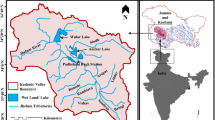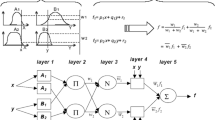Abstract
The ability of the adaptive neuro-fuzzy inference algorithm architecture to simulate floods is explored in this research. The development of models for flood forecasting has been centered on two adaptive neuro-fuzzy inference (ANFIS) algorithms. The Takagi–Sugeno fuzzy inference systems (FIS) generated through subtracted clustering were trained using hybrid and backpropagation training algorithms. Multiple statistical performance evaluators were used to assess the performability of the established models. The validity and predictive power of the models are evaluated by estimating a flood occurrence in the study area. In designing the models, a total of 12 inputs were employed. The best performability was found for the ANFIS model created utilizing a hybrid training algorithm with mean square error (MSE) of 0.00034, co-efficient of correlation (R2) of 97.066%, root mean square error (RMSE) of 0.018, Nash–Sutcliffe model efficiency (NSE) of 0.968, mean absolute error (MAE) of 0.0073 and combined accuracy (CA) of 0.018, indicating the possible usage of exploiting the established model for prediction of floods.









































































Similar content being viewed by others
Availability of data and material
The data used in the study were procured from various agencies recognized by the Government of India mentioned in the manuscript.
Code availability
Not applicable.
References
Abebe Y, Kabir G, Tesfamariam S (2018) Assessing urban areas vulnerability to pluvial flooding using GIS applications and Bayesian Belief Network model. J Clean Prod 174:1629–1641. https://doi.org/10.1016/j.jclepro.2017.11.066
Ashrafi M, Chua LHC, Quek C, Qin X (2017) A fully-online Neuro-Fuzzy model for flow forecasting in basins with limited data. J Hydrol 545:424–435. https://doi.org/10.1016/j.jhydrol.2016.11.057
Bazartseren B, Hildebrandt G, Holz KP (2003) Short-term water level prediction using neural networks and neuro-fuzzy approach. Neurocomputing 55:439–450. https://doi.org/10.1016/S0925-2312(03)00388-6
Bhat MS, Alam A, Ahmad B, Kotlia BS, Farooq H, Taloor AK, Ahmad S (2019) Flood frequency analysis of river Jhelum in Kashmir basin. Quat Int 507(October):288–294. https://doi.org/10.1016/j.quaint.2018.09.039
Bhutiyani MR, Kale VS, Pawar NJ (2010) Climate change and the precipitation variations in the northwestern Himalaya:1866–2006. Int J Climatol 548(April 2009), 535–548.https://doi.org/10.1002/joc.1920
Bhuvan-ISRO (2018) Bhuvan-Indian Geo-platform of ISRO. Retrieved August 25, 2020, from https://bhuvan.nrsc.gov.in/bhuvan_links.php
Chan FKS, Chuah CJ, Ziegler AD, Dąbrowski M, Varis O (2018) Towards resilient flood risk management for Asian coastal cities: Lessons learned from Hong Kong and Singapore. J Clean Prod 187:576–589. https://doi.org/10.1016/j.jclepro.2018.03.217
Chang FJ, Chang YT (2006) Adaptive neuro-fuzzy inference system for prediction of water level in reservoir. Adv Water Resour 29(1):1–10. https://doi.org/10.1016/j.advwatres.2005.04.015
Chang FJ, Chen YC (2001) A counterpropagation fuzzy-neural network modeling approach to real time streamflow prediction. J Hydrol 245(1–4):153–164. https://doi.org/10.1016/S0022-1694(01)00350-X
Chapi K, Singh VP, Shirzadi A, Shahabi H, Bui DT, Pham BT, Khosravi K (2017) A novel hybrid artificial intelligence approach for flood susceptibility assessment. Environ Model Softw 95:229–245. https://doi.org/10.1016/j.envsoft.2017.06.012
Chen SH, Lin YH, Chang LC, Chang FJ (2006) The strategy of building a flood forecast model by neuro-fuzzy network. Hydrol Process 20(7):1525–1540. https://doi.org/10.1002/hyp.5942
Dariane AB, Azimi S (2018) Streamflow forecasting by combining neural networks and fuzzy models using advanced methods of input variable selection. J Hydroinf 20(2):520–532. https://doi.org/10.2166/hydro.2017.076
Dhanya CT, Nagesh Kumar D (2009) Fuzzy association rules for prediction of monsoon rainfall. In: Proceedings of the 4th Indian international conference on artificial intelligence, IICAI 2009, (May 2014), pp 1299–1309.
Ding X, Hua D, Jiang G, Bao Z, Yu L (2017) Two-stage interval stochastic chance-constrained robust programming and its application in flood management. J Clean Prod 167:908–918. https://doi.org/10.1016/j.jclepro.2017.07.205
Firat M (2008) Comparison of Artificial Intelligence Techniques for river flow forecasting. Hydrol Earth Syst Sci 12(1):123–139. https://doi.org/10.5194/hess-12-123-2008
Gautam DK, Holz KP (2001) Rainfall-runoff modelling using adaptive neuro-fuzzy systems. J Hydroinf 3(1):3–10
Hu M, Zhang X, Li Y, Yang H, Tanaka K (2019) Flood mitigation performance of low impact development technologies under different storms for retrofitting an urbanized area. J Clean Prod 222:373–380. https://doi.org/10.1016/j.jclepro.2019.03.044
Hua P, Yang W, Qi X, Jiang S, Xie J, Gu X, Krebs P (2020) Evaluating the effect of urban flooding reduction strategies in response to design rainfall and low impact development. J Clean Prod 242:118515. https://doi.org/10.1016/j.jclepro.2019.118515
Illahi U, Mir MS (2020a) Comparative analysis of background subtraction and CNN algorithms for mid-block traffic data collection and classification. Int J Math Eng Manag Sci 5(6):1440–1451. https://doi.org/10.33889/IJMEMS.2020.5.6.107
Illahi U, Mir MS (2020b) Modeling Sustainable mobility using fuzzy logic: an application to selected Indian States. In: Gunjan VK, Kumar A, Gao X-Z (Eds.), Advances in cybernetics, for communication machine learning cognition, and technologies (pp. 107–114).https://doi.org/10.1007/978-981-15-3125-5_12
Illahi U, Mir MS (2020) Sustainable Transportation Attainment Index: multivariate analysis of indicators with an application to selected states and National Capital Territory (NCT) of India. Environ Dev Sustain. https://doi.org/10.1007/s10668-020-00734-w
Illahi U, Mir MS (2021) An indicator-based integrated methodology for evaluating sustainability in transportation systems using multivariate statistics and fuzzy logic. J Sci Technol Policy Manag. https://doi.org/10.1108/JSTPM-12-2019-0116
IMD (2018) Indian Metereological Department-Ministry of Earth Sciences, Government of India. Retrieved April 22, 2018, from https://mausam.imd.gov.in/
IWP (2018) India Water Portal. Retrieved June 28, 2018, from https://www.indiawaterportal.org/met_data/
Jang JR (1993) ANFIS: adaptive-network-based fuzzy inference system. IEEE Trans Syst Man Cybern 23(3):665–685. https://doi.org/10.1109/21.256541
Kant A, Suman PK, Giri BK, Tiwari MK, Chatterjee C, Nayak PC, Kumar S (2013) Comparison of multi-objective evolutionary neural network, adaptive neuro-fuzzy inference system and bootstrap-based neural network for flood forecasting. Neural Comput Appl 23(SUPPL1):231–246. https://doi.org/10.1007/s00521-013-1344-8
Kasabov NK, Song Q (2002) DENFIS: dynamic evolving neural-fuzzy inference system and its application for time-series prediction. IEEE Trans Fuzzy Syst 10(2):144–154. https://doi.org/10.1109/91.995117
Keskin ME, Taylan D, Terzi Ö (2006) Adaptive neural-based fuzzy inference system (ANFIS) approach for modelling hydrological time series. Hydrol Sci J 51(4):588–598. https://doi.org/10.1623/hysj.51.4.588
Kumar DN, Raju KS, Sathish T (2004) River flow forecasting using artificial neural networks. Int J Mech Eng Technol 18:143–161. https://doi.org/10.1201/b16994-60
Kumar DN, Reddy MJ, Maity R (2007) Regional rainfall forecasting using large scale climate teleconnections and artificial intelligence techniques. J Intell Syst 16(4):307–322. https://doi.org/10.1515/jisys.2007.16.4.307
Latt ZZ, Wittenberg H (2014) Improving flood forecasting in a developing country: a comparative study of stepwise multiple linear regression and artificial neural network. Water Resour Manage 28(8):2109–2128. https://doi.org/10.1007/s11269-014-0600-8
Mekanik F, Imteaz MA, Talei A (2016) Seasonal rainfall forecasting by adaptive network-based fuzzy inference system (ANFIS) using large scale climate signals. Clim Dyn 46(9–10):3097–3111. https://doi.org/10.1007/s00382-015-2755-2
Meraj G, Romshoo SA, Yousuf AR, Altaf S, Altaf F (2015) Assessing the influence of watershed characteristics on the flood vulnerability of Jhelum basin in Kashmir Himalaya. Nat Hazards 78(1):1–5. https://doi.org/10.1007/s11069-015-1861-0
Mosavi A, Ozturk P, Chau KW (2018) Flood prediction using machine learning models: literature review. Water (Switzerland) 10(11):1–40. https://doi.org/10.3390/w10111536
Mukerji A, Chatterjee C, Raghuwanshi NS (2009) Flood forecasting using ANN, neuro-fuzzy, and neuro-GA models. J Hydrol Eng 14(6):647–652. https://doi.org/10.1061/(ASCE)HE.1943-5584.0000040
Nayak PC, Sudheer KP, Rangan DM, Ramasastri KS (2005) Short-term flood forecasting with a neuro-fuzzy model. Water Resour Res 41(4):1–16. https://doi.org/10.1029/2004WR003562
Nguyen P, Thorstensen A, Sorooshian S, Hsu K, Aghakouchak A, Sanders B, Smith M (2015) A high resolution coupled hydrologic–hydraulic model ( HiResFlood-UCI ) for flash flood modeling. J Hydrol. https://doi.org/10.1016/j.jhydrol.2015.10.047
Noymanee J, Nikitin NO, Kalyuzhnaya AV (2017) Urban pluvial flood forecasting using open data with machine learning techniques in Pattani Basin. Procedia Comput Sci 119(2017):288–297. https://doi.org/10.1016/j.procs.2017.11.187
Özger M (2009) Comparison of fuzzy inference systems for streamflow prediction. Hydrol Sci J 54(2):261–273. https://doi.org/10.1623/hysj.54.2.261
Patel D, Parekh F (2014) Flood forecasting using adaptive neuro-fuzzy inference system (ANFIS). Int J Eng Trends Technol 12(10), 510–514. Retrieved from http://www.ijettjournal.org
Pourghasemi HR, Gayen A, Panahi M, Rezaie F, Blaschke T (2019) Multi-hazard probability assessment and mapping in Iran. Sci Total Environ 692:556–571. https://doi.org/10.1016/j.scitotenv.2019.07.203
Qasem SN, Ebtehaj I, Madavar HR (2017) Optimizing ANFIS for sediment transport in open channels using different evolutionary algorithms. J Appl Res Water Wastewater 7:290–298
Rashetnias S (2016) Flood vulnerability assessment by applying a fuzzy logic method : a case study from Melbourne. Victoria University, Melbourne, Australia
Rasool T, Dar AQ, Wani MA (2020) Quantification of spatial variability of soil physical properties in a Lesser Himalayan Sub-Basin of India. Eurasian Soil Sci 53(3):362–376. https://doi.org/10.1134/S1064229320030060
Roodsari BK, Chandler DG, Kelleher C, Kroll CN (2019) A comparison of SAC-SMA and adaptive neuro-fuzzy inference system for real-time flood forecasting in small urban catchments. J Flood Risk Manag 12(S1):1–12. https://doi.org/10.1111/jfr3.12492
Saleh SF, Rather FF, Jabbar MJ (2017) Floods and mitigation techniques with reference to Kashmir. Int J Eng Sci Comput 7(4):6359–6363
Shu C, Ouarda TBMJ (2008) Regional flood frequency analysis at ungauged sites using the adaptive neuro-fuzzy inference system. J Hydrol 349(1–2):31–43. https://doi.org/10.1016/j.jhydrol.2007.10.050
Singh VK, Kumar P, Singh BP, Malik A (2016) A comparative study of adaptive neuro fuzzy inference system (ANFIS) and multiple linear regression (MLR) for rainfall-runoff modelling. Int J Sci Nat 7(4), 714–723
Solgi A, Zarei H, Nourani V, Bahmani R (2017) A new approach to flow simulation using hybrid models. Appl Water Sci 7(7):3691–3706. https://doi.org/10.1007/s13201-016-0515-z
Sun Y, Tang D, Sun Y, Cui Q (2016) Comparison of a fuzzy control and the data-driven model for flood forecasting. Nat Hazards 82(2):827–844. https://doi.org/10.1007/s11069-016-2220-5
Tabbussum R, Dar AQ (2020a). Analysis of Bayesian regularization and Levenberg–Marquardt training algorithms of the feedforward neural network model for the flow prediction in an alluvial Himalayan river, pp 43–50.https://doi.org/10.1007/978-981-15-1632-0_5
Tabbussum R, Dar AQ (2020b) Comparative analysis of neural network training algorithms for the flood forecast modelling of an alluvial Himalayan river. J Flood Risk Manag 13(4):1–18. https://doi.org/10.1111/jfr3.12656
Tabbussum R, Dar AQ (2020c) Comparison of fuzzy inference algorithms for stream flow prediction. Neural Comput Appl. https://doi.org/10.1007/s00521-020-05098-w
Tabbussum R, Dar AQ (2021) Performance evaluation of artificial intelligence paradigms—artificial neural networks, fuzzy logic , and adaptive neuro-fuzzy inference system for flood prediction. Environ Sci Pollut Res, (Ml).https://doi.org/10.1007/s11356-021-12410-1
Talei A, Chua LHC, Wong TSW (2010) Evaluation of rainfall and discharge inputs used by Adaptive Network-based Fuzzy Inference Systems (ANFIS) in rainfall-runoff modeling. J Hydrol 391(3–4):248–262. https://doi.org/10.1016/j.jhydrol.2010.07.023
Tsakiri K, Marsellos A, Kapetanakis S (2018) Artificial neural network and multiple linear regression for flood prediction in Mohawk River, New York. Water (Switzerland). https://doi.org/10.3390/w10091158
Wang Y, Hong H, Chen W, Li S, Panahi M, Khosravi K, Costache R (2019) Flood susceptibility mapping in Dingnan county (China) using adaptive neuro-fuzzy inference system with biogeography based optimization and imperialistic competitive algorithm. J Environ Manage 247:712–729. https://doi.org/10.1016/j.jenvman.2019.06.102
Werbos PJ (1988) Generalization of backpropagation with application to a recurrent gas market model. Neural Netw 1(4):339–356. https://doi.org/10.1016/0893-6080(88)90007-X
Zeleňáková M, Fijko R, Labant S, Weiss E, Markovič G, Weiss R (2019) Flood risk modelling of the Slatvinec stream in Kružlov village, Slovakia. J Clean Prod 212:109–118. https://doi.org/10.1016/j.jclepro.2018.12.008
Zhou Y, Guo S, Chang FJ (2019) Explore an evolutionary recurrent ANFIS for modelling multi-step-ahead flood forecasts. J Hydrol 570:343–355. https://doi.org/10.1016/j.jhydrol.2018.12.040
Acknowledgments
We would like to thank the MHRD, India for funding the research.
Funding
This research is funded by the MHRD- India, through the scholarship granted to Ruhhee Tabbussum.
Author information
Authors and Affiliations
Corresponding author
Ethics declarations
Conflict of interest
The authors don’t have any conflict of interest to disclose.
Additional information
Publisher's Note
Springer Nature remains neutral with regard to jurisdictional claims in published maps and institutional affiliations.
Rights and permissions
About this article
Cite this article
Tabbussum, R., Dar, A.Q. Modelling hybrid and backpropagation adaptive neuro-fuzzy inference systems for flood forecasting. Nat Hazards 108, 519–566 (2021). https://doi.org/10.1007/s11069-021-04694-w
Received:
Accepted:
Published:
Issue Date:
DOI: https://doi.org/10.1007/s11069-021-04694-w




